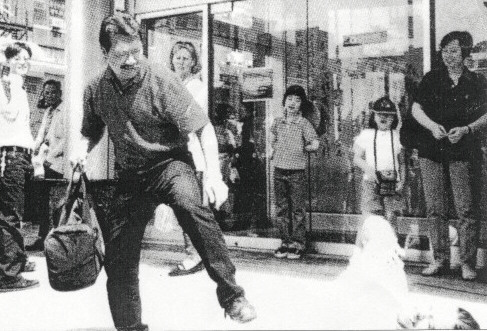The Pillars of Ving Tsun
In its classical form (meaning passed from one genuine sifu to another without modification), Ving Tsun is regarded as an effective fighting system for three primary reasons:
First, CVT's primary pillar is that of its classical lineage with no deviation from its basic theories and principles. This obstinate clinging to classicism is the student's assurance that what he is learning is not significantly different from that which Ng Mui imparted to her first students. Some would argue that this obstinancy hinders any betterment of the system that otherwise would have occurred, but a system that ain't broke doesn't need fixing. Furthermore, CVT's effectiveness is heavily supported by its consistent production of effective fighters.
The second pillar upon which CVT stands is its introspective approach. Rather than stressing and capitalising on its own strengths, CVT uniquely focuses on its weaknesses in a constant effort to minimize them. One could also say that they system looks inward on itself, rather than externally to how it matches up to other styles. CVT has reached such a state of perfection that even a potential knock-out blow will not be taken if it means unduly exposing a target to the opponent. In short, CVT never stops asking why, and never overlooks a tactical possibility.
CVT's final and most practical pillar lies in its realism. The world of fighting is infinite, varied and unpredictable, as are the fighters themselves. Understanding this unpredictability of fighting has aided CVT in producing a system that stresses sensitivity over reaction - that is, no particular stimulus can be expected to produce a specific response. CVT is one of the few fighting systems that have not gotten caught-up in sport fighting, kata competitions, or the spiritual grab-bag. CVT has not lost sight of its original purpose of producing a mature fighter with effective control over both his emotional and physical abilities. What exists outside of reality is of no interest to the CVT practitioner, for time is better spent on learning what works than on what ought to work.
The system supported by these three pillars is a complete one that is widely applicable to nearly every situation, whether it be bar fights, street fights, multiple opponents, slippery/uneven footing, grappling etc. The aim of CVT is to produce well-rounded, non-committal, mature fighters who will never be surprised or at a loss in a real-life situation.
Since a female created the system, it could be said that it works better for frail, small statured students. That is not totally the case, as larger students have an innate advantage in strength, and so have an edge over smaller students of an equal skill level. Ironically, though, smaller students tend to be more coordinated and more sensitive, and therefore pick up the system more quickly than a larger, especially bulkier, student. So, there is a balancing formular here: larger students have innate strength advantages but innate speed and coordination disadvantages when compared with smaller students.
Many other styles require constant training and daily exercise, also become obsolete when the fighter reaches a certain age because of their emphasis on external training. Approaching CVT Kung Fu in a a realistic fashion provides two primary benefits: low maintenance and long shelf-life. A well trained CVT practitioner, on the more practical end, requires only 3 hours a week to maintain the fighting sensitivity that is at the system's heart. CVT stresses an internal strength which relies on internal energy, sensitivity, timing and awareness, as opposed to external physical strength, power and muscle.
Grandmaster Kan himself is over 60 years old, is still in top fighting condition and teaching CVT full time.




